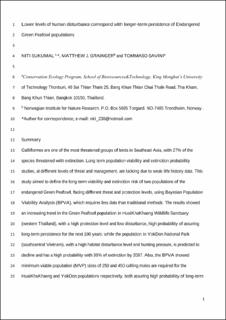Lower levels of human disturbance correspond with longer-term persistence of Endangered Green Peafowl Pavo muticus populations
Peer reviewed, Journal article
Accepted version

View/
Date
2020Metadata
Show full item recordCollections
- Scientific publications [1392]
Original version
10.1017/S0959270919000443Abstract
Galliformes are one of the most threatened groups of birds in South-East Asia, with 27% of the species threatened with extinction. Long term population viability and extinction probability studies, at different levels of threat and management, are lacking due to weak life history data. This study aimed to define the long-term viability and extinction risk of two populations of the endangered Green Peafowl Pavo muticus, facing different threat and protection levels, using Bayesian Population Viability Analysis (BPVA), which requires less data than traditional methods. The results showed an increasing trend in the Green Peafowl population in HuaiKhaKhaeng Wildlife Sanctuary (western Thailand), with a high protection level and low disturbance and high probability of assuring persistence for the next 100 years. By contrast, the population in YokDon National Park (south-central Vietnam), with a high habitat disturbance level and significant hunting pressure, is predicted to decline and has a high probability (99%) of extinction by 2097. Also, the BPVA showed minimum viable population (MVP) estimates of 250 and 450 calling males for the HuaiKhaKhaeng and YokDon populations respectively, assuring high probabilities of long-term persistence if the minimum numbers of males are available. The population size of 219 calling males at YokDon during the 2013 survey is lower than the MVP threshold of 450 calling males, which suggests the species has a low probability of long-term persistence in the area. Despite limited life history and population data, BPVA predicted the future of this population under site-specific conditions, and the results could be used to promote better management and population restoration